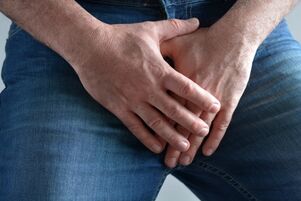
Prostatitis, like other diseases, manifests itself with certain symptoms. It is important for a man to know the first signs accurately, as it is a signal to see a doctor and further examination. We will discuss how various forms of prostate gland inflammation and first aid measures appear in the article.
Briefly about prostate and prostatitis
The prostate gland in adult men is a glandular organ, consisting of two lobules and one capsule, as well as the adjacent prostate urethra. Prostate performs 3 functions at once:
- Regulates the density of semen by producing prostate juice and diluting ejaculation with it.
- Blocks the urethra during orgasm.
- Participate in the production of certain hormones, or control their levels in the body.
If the male reproductive system fails, the first signs will be associated with this prostate function.
As a result of the invasion of pathogenic microflora into the prostate or after injury, hypothermia, as well as stagnant processes, inflammation begins. In this case, blood microcirculation is disrupted, lymph outflow, venous blood and prostate secretion worsen. This leads to the development of edema and enlargement of the glands in size. As a result, the tissues are compressed, a man has a feeling of heaviness in the perineum or slight pain in the lower abdomen - the first sign of prostatitis to occur.
The clinical picture will depend a lot on the form of the inflammatory process and the causes that cause it.
Symptoms of Acute Bacterial Prostatitis
It is very difficult to miss the first symptoms of acute prostatitis - they appear suddenly and develop rapidly. Usually 2-4 days pass between the onset of the inflammatory process and the first sign. In this case, the clinical picture will depend on the stage of the disease.
In this case, the clinical picture will depend on the stage of the disease.
Acute catarrhal inflammation
The first sign of this type of prostatitis is a feeling of heaviness in the perineum area, as well as increased urination at night. Body temperature does not increase with this form, as men often ignore existing problems or try to overcome them on their own, thus provoking the next level.
Acute follicular inflammation
At this stage, the first signs of prostatitis will be more pronounced. Many men are no longer at risk for self-medication, but see a doctor. Complaints will be very different:
- There is a dull pain in the perineum, can radiate to the coccyx or anus.
- Urination is painful, the man has difficulty, which means that acute urinary retention may develop.
- Pain during defecation, because the man could not go to the toilet.
These are the first symptoms of acute follicular prostatitis, further they may experience fever up to 38 degrees, depression in general, weakness, lethargy. The man becomes irritable, libido decreases, erectile dysfunction may appear.
These symptoms persist, and if there is no proper treatment, the next stage will develop.
Acute parenchymal inflammation
The inflammatory process has already spread to the parenchyma tissue, so it is growing rapidly. The first thing a sick person will notice is an increase in body temperature to a high value (from 39 ° C), chills, dry mouth. The pain will be severe, throbbing, can be felt in the perineum and in the lower back, in the abdomen, genitals.
Urination will also change. A man will first see an intermittent flow, and then he will not be able to empty his bladder due to severe pain. If you do not call an ambulance, there will be signs of digestive disorders - bloating, constipation, abdominal pain with different localization. Fetal mucus is removed from the anus.
You can understand that acute parenchyma prostatitis begins with a special feature: the pain disappears if you lie on your back and lift your legs up. This is a clear signal that medical treatment is urgently needed.
The first signs of chronic prostatitis

Chronic prostatitis is a prolonged inflammation of the prostate gland, so the first signs begin, most often, in the acute form. However, a man from time to time expects a worsening period, and here you need to understand what symptoms they will accompany. Often, men complain about the following health problems:
- Burns around the penis glands, especially during ejaculation or urination;
- Mild pain in the perineum, can radiate to the pubis;
- Slight increase in body temperature.
With chronic prostatitis, erectile problems will definitely start, as well as the ability to participate in child conception. This is due to the deterioration of prostate function, due to which the blood supply to the penis changes, and the quality of sperm also declines.
At the first sign of worsening prostatitis, you need to undergo treatment. It is not recommended to use pills prescribed by a doctor in advance without prior examination.
Clinical description of the disease
Regardless of the form of the inflammatory process and the causes that cause it, a man will experience three significant symptoms, with only differences in the intensity of their manifestations. Prostatitis is always accompanied by urinary disorders, pain and erectile dysfunction.
Urine with prostatitis is excreted in drops or its flow is intermittent. Sometimes jets are sprayed and then it is problematic for a man to get rid of small needs while standing. The urge to urinate is more common at night, especially in the morning. With stones in the prostate, urine can turn pink due to blood mixing.

With prostatitis, epithelial cells and other cells accumulate in the urethra, and bacteria can also multiply. This leads to an increased burning sensation during urination or ejaculation.
Pain is also unavoidable. Depending on the severity of the pathological process, the process may be:
- whine;
- stupid;
- shooting (pulsating).
Their most common localization is the perineal area, just below the testicles. Radiation to the coccyx, sacrum, pubis, penis is not excluded. Also, pain can occur in the anus, especially during pushing, as a man often suffers from constipation.
As for body temperature, it rarely rises to 38 degrees. The exception is parenchymal and purulent prostatitis, in which these indicators can reach 40 degrees and are accompanied by chills, severe depression, and sometimes confusion. In such cases, the temperature with prostatitis threatens the patient's life.
First aid for prostatitis
Treatment of prostatitis may also be done outpatiently, if we do not discuss the purulent process. But in this case, one can not do without going to the doctor for a referral for examination and treatment tactic options. However, the first signs of prostatitis may appear when a man is unable to call an ambulance, so you need to know some first aid principles.

- When the temperature rises above 38 degrees, you can take antipyretics.
- To reduce pain, it is best to lie on your back and lift your legs as high as possible (leaning against a wall or furniture).
- For severe pain, you can take an antispasmodic or insert a suppository.
As soon as possible, you need to see a doctor, while at the reception, you need to state the medication you have taken and in what dose.
Traditional methods can only be used after confirming the diagnosis and only with the permission of the attending physician.
How prostatitis manifests itself in analysis
Prostatitis refers to a disease that has no symptoms attached to them alone. For example, a burning sensation when urinating can occur with urethritis, and pain in the lower abdomen - with appendicitis or cystitis. Therefore, the final diagnosis is not made on the patient's complaint, but on the results of laboratory tests of blood, urine, semen and prostate juice. This also takes into account rectal examination data, TRUS and a number of other instrumental methods.
The following diagnostic features are characteristic of prostatitis:
- Presence of bacteria or fungi in urine and prostate fluid.
- Presence of leukocyte cells in urine and blood tests.
- Decreased number of leukocyte seeds with a background of increased leukocyte count in prostate secretion;
- Blood in urine or semen;
- Reduction of erythrocyte deposition rate in blood tests.
- Pain on palpation of the prostate, size change and consistency.
- Changes in echogenicity, details, contours based on TRUS results.
The combination of these symptoms with a well-being complaint allows us to make an accurate diagnosis, which means that treatment will be prescribed correctly. The patient's quality of life, the speed of his recovery, and in some cases his life depends on this.
Conclusion
Knowing the first signs of prostatitis in men, you can see changes in well-being over time and take steps early. If pain in the perineum begins, the flow of urine becomes infrequent, and the urge to urinate becomes more frequent - this is a reason to suspect inflammation of the prostate and a signal to see a doctor. It is better not to treat yourself in these cases.
























